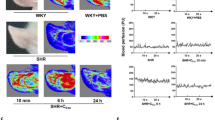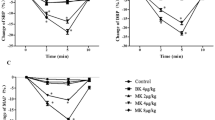Abstract
To investigate the action mechanisms of a new erythrocyte-derived depressing factor (EDDF), the focus is placed on the effect of EDDF on both cytosolic and nuclear free calcium (Ca2+) transportation in vascular smooth muscle cell (VSMC), as well as the apoptosis and cell cycle of VSMC of rats. EDDF has been extracted from human erythrocytes. The changes of Ca2+ levels in cytoplasm ([Ca2+]i) and nucleus ([Ca2+]n) have been observed using a laser scanning confocal microscope together with fluo-3/AM as a calcium indicator. Flow cytometric technique was used to study the effect of EDDF on cell cycle and apoptosis of VSMC. [Ca2+], and [Ca2+]n were significantly decreased through several different pathways: ( i ) it reduced the Ca2+ influx by blocking L-type voltage-dependent calcium channel (L-VDC) and R-type voltage-dependent calcium channel (R-VDC); (ii) it inhibited the Ca2+ release from inositol 1, 4, 5-trisphosphate (IP3) sensitive calcium store; and (iii) activated Ca2+-ATPase of sarcoplasmic reticulum (SR) and promoted the transportation of Ca2+ from cytoplasm to SR. However, EDDF seemed to have little inhibitory effect on the Ca2+ release from ryonodine sensitive calcium pool. It was also found that EDDF (10−4 g/mL) significantly decreased the proportion of S phase of human umbilical vein (HUV) and inhibited the proliferation of VSMC induced by angiotensin II (Angll, 10−5 mol/L). The apopotosis did not occur when VSMC was cultured under normal condition. While VSMC apoptosis was induced by Angll (10−5 mol/L) and EDDF (10−4 g/mL) seemed to have little effect on it. The inhibitory effect of EDDF on the elevation of [Ca2+]i and [Ca2+]n of VSMC might play an essential role in its action mechanisms and the ways it affects the Ca2+ handling of VSMC demonstrate that EDDF was different from other endogenous blood pressure regulators and some known antihypertensive drugs. EDDF could inhibit the proliferation of VSMC, which indicated that it might be beneficial to the prevention and treatment of hypertension and arteriosclerosis.
Similar content being viewed by others
References
Wen, Y. Y., Vascular alterations and their mechanisms in hypertension, in The Vascular Biology (eds. Han, Q. D., Wen, Y. Y.), Beijing: Union Publishing House of Beijing Medical University and Peking Union Medical College, 1997, 220.
Chang, X. C., Wen, Y. Y., Xu, X. R. et al., Study on the acuty toxicity of erythrocyte antihypertensive factor from human being, Chinese Academy of Physiological Science (CAPS) News Communication, 1998, 17(Suppl. 1): 165.
Slain, M., Vascular calcium overload produced by vitamin D3, Cadiovascular Res., 1995, 30: 1038.
Rhian, M., Tony, Z., Barbara, T. et al., Blunted attenuation of angiotension II-mediated Ca2+ transsicents by insulin in cultured unpassaged VSMC from spontanious hypertensive rat, Am. J. Hypertens., 1995, 8: 104.
Micheal, B., Gabriel, C., Ernst, B. et al., Confocal microscopy to analyze cytosolic and nuclear calcium in cultured vascular cells, Am. J. Physiol., 1995, 266: c1118.
Ikeda, M., Ariyoshi, H., Kambayashi, J. et al., Separate analysis of nuclear and cytosolic Ca2+ concentrations in human ambilical vein endothelial cells, J. Cell Biochem., 1996, 3(1): 23.
Perez, T. C., Stehno, B. L., Clapham, D. E., Nucleoplasm alter the fluorescence properties of fluo-3,Cell Calcium, 1997, 21(4): 275.
Miwa, T., Endou, M., Okumura, F., Prostaglandin E1 potentiation of the spontaneous phasic contraction of rat isolated portal vein a cyclopiazonic sensitive mechanism, Br. J. Pharmacol., 1997, 120(8): 1419.
Javors, M. A., King, T. S., Chang, X. et al., Characterization of K+ induced increase in [Ca2+]cyl and GnRH relasein GT1-7 neurons, Brain Res., 1995, 694(1–2): 49.
James, W., Pntney, J. R., Type 3 IP3 receptor and capacitative calcium entry, Cell Calcium, 1997, 21(3): 257.
Nomura, Y., Asano, M., Ito, K. et al., Poten vasoconstrictor action of CPA and thapsigargin on femoral arteries from spontaneously hypertensive rats, Br. J. Pharmacol., 1997, 120(1): 65.
Fukuta, Y., Yoshizumi, M., Kitagawa, T. et al., Angiotensin II as a stimulator of Na+-dependent Ca2+ efflux from fresh isolated adult rat cardiomyoctes, Neurosci. Lett., 1996, 213(2): 95.
Abe, F., Karaki, H., Endoh, M., Effects of cyclopiazonic acid and ryanodine on cytosolic calcium and contraction in vascular smooth muscle, Br. J. Pharmacol., 1996, 118(7): 1711.
Binara, Y., Asano, M., Ito, K. et al., Superficial saroplasmic reticulum calcium buffering of resting and voltage-dependent Ca2+ influx in rat femoral arterial smooth muscle, J. Pharmacol. Exp. Ther., 1996, 279(2): 830.
Deblois, D., Tea, B. S., Dam, T. V. et al., Smooth muscle apoptosis during vascular regression in spontaneously hypertensive rats, Hypertension, 1997, 29(1): 340.
Author information
Authors and Affiliations
Corresponding author
About this article
Cite this article
Wen, Y., Zhang, X., Xu, X. et al. Action mechanisms of a new erythrocyte-derived depressing factor. Chin. Sci. Bull. 45, 2113–2118 (2000). https://doi.org/10.1007/BF02886313
Received:
Issue Date:
DOI: https://doi.org/10.1007/BF02886313




